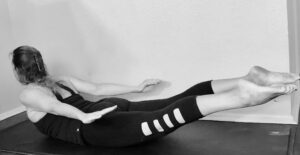For SALABHASANA – LOCUST POSE, begin by coming to the mat on your stomach using optional extra padding under the hip area as the is posture will be resting on the pelvic bones. Arms are down by your sides with palms facing down toward the mat. The tops of your feet are touching the mat. Bring your chin or forehead to the mat to prepare for the posture.

Engage your core muscles. Inhale, lifting your head, chest and arms off the floor, optionally bringing your legs off the floor. Slide your shoulder blades back and down while reaching through your fingertips. Your gaze should be in just in front of you on the floor. Keep the head in the same line with the spine to keep the neck safe. Next, inhale lengthen and stretch the arms and legs upward and outward, exhale relax or release. You can come in and out of the posture as needed.
Note: There is some discrepancy regarding this pose. Locust can be performed with the palms on the mat, by the sides or under the body for more challenge. Some might call this particular pose Navasana – Upward Facing Boat with palms facing upward.
Benefits:
Locust, a very challenging posture, also has many rewards. It strengthens the back, glutei, leg and arm muscles. It strengthens the neck muscles, helping to bring blood and oxygen to the neck area. This is important for those how may store their tension in the neck area. It helps to relieve tension and pain caused from chronic tension. Locust puts pressure on the abdomen, therefore, aiding in digestion, while also toning the abdomen area. This posture helps to replenish the spinal cord. Locust also helps the reproductive area by stimulating the organs.
A suggestion for your next pose: Cobra.